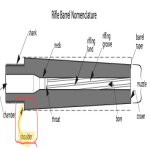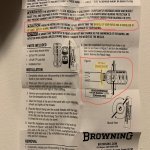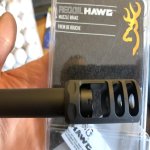Wasn’t sure if this should be here or in the general firearms discussion…
I recently purchased a muzzle brake, and now that I have the package I've learned a new definition of barrel “shoulder”, and apparently this may affect whether it can be used.
I’m relatively new to this, but I thought barrel shoulder was a dimension from closer to the chamber end (not muzzle end). Such as in this picture below:

(Image from: https://www.americanrifleman.org/content/back-to-basics-rifle-barrels/ )
The muzzle brake is a Browning Recoil Hawg, and the product description says:
I have a 5/8” x 24 threaded barrel which tapers down to about 0.675”, so figured it’d be good to go. I prefer the look of this muzzle brake compared to some with the external nut for tightening, looks cleaner in my opinion. Once I received the package and read the installation instructions, apparently barrel shoulder is the diameter at the muzzle?

Is there an actual risk associated with the 0.025” (or 0.0125” radially) discrepancy? I installed it to sort of get a sense of things, and it seems to fit, as the 5/8” threaded section holds it in place, and there is no “gap” visible at the “shoulder”. Also, there is no play or wiggle room with the 5/8” threaded section holding it, and this should still be concentrically aligned with the bore, as it is governed by the 5/8” (I.e. not like it is 0.025” off-centre).

What do you think CGN? I’ll probably try call the manufacturer during business hours next week, but unless I can get ahold of a gunsmith or someone on the design team, I’ll probably get a generic answer about 0.700” minimum.
I recently purchased a muzzle brake, and now that I have the package I've learned a new definition of barrel “shoulder”, and apparently this may affect whether it can be used.
I’m relatively new to this, but I thought barrel shoulder was a dimension from closer to the chamber end (not muzzle end). Such as in this picture below:

(Image from: https://www.americanrifleman.org/content/back-to-basics-rifle-barrels/ )
The muzzle brake is a Browning Recoil Hawg, and the product description says:
The Recoil Hawg will fit most bull and heavy-sporter profile rifle barrels with a minimum barrel shoulder of .700" and 5/8"-24 TPI or 1/2"-28 TPI muzzle threads.
I have a 5/8” x 24 threaded barrel which tapers down to about 0.675”, so figured it’d be good to go. I prefer the look of this muzzle brake compared to some with the external nut for tightening, looks cleaner in my opinion. Once I received the package and read the installation instructions, apparently barrel shoulder is the diameter at the muzzle?

Is there an actual risk associated with the 0.025” (or 0.0125” radially) discrepancy? I installed it to sort of get a sense of things, and it seems to fit, as the 5/8” threaded section holds it in place, and there is no “gap” visible at the “shoulder”. Also, there is no play or wiggle room with the 5/8” threaded section holding it, and this should still be concentrically aligned with the bore, as it is governed by the 5/8” (I.e. not like it is 0.025” off-centre).

What do you think CGN? I’ll probably try call the manufacturer during business hours next week, but unless I can get ahold of a gunsmith or someone on the design team, I’ll probably get a generic answer about 0.700” minimum.









































































